This DMX Shield enables sending and receiving DMX signals by using a save DMX hardware including isolation. Ideal for DMX projects without risking processor damages from high voltage peaks.
I had published some previous versions here. This is the newest version of the shield that has no additional functions and works exactly like the shield in version v03 that is in use in multiple installations. But there are some improvements by adjusting some values and make its use more flexible when using it on top of an Arduino MEGA and other shields.
Download the project files including the Eagle based schema and board design:
I sometimes may have some boards available so you can ask for per mail.
The ideas behind the hardware design are:
The schema for this board is designed to use the standard serial interface of the Arduino board for sending and reveiving DMX data packages. Therefore the pin 0 and 1 are used to read and send the data. To switch the data direction between sending and receiving the digital pin 2 is used.
Here is the complete layout (click to enlarge):
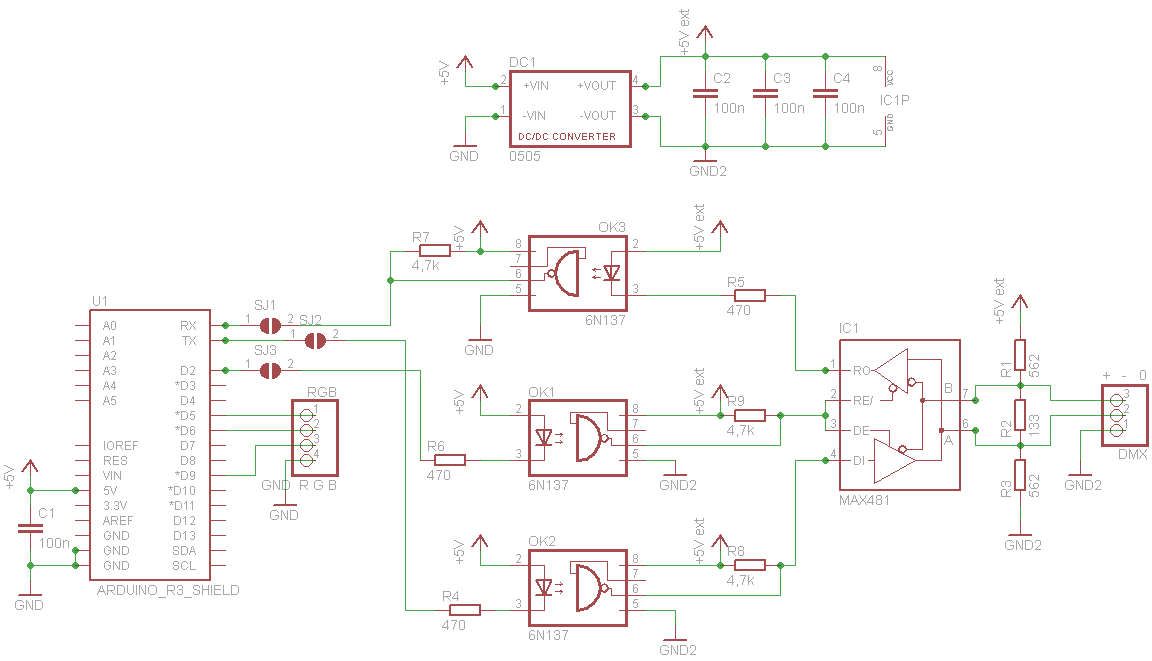
(click to open a full size picture).
The details of the shield design are discussed below.
Here is a picture of a fully assembled shield on top of an Arduino UNO:
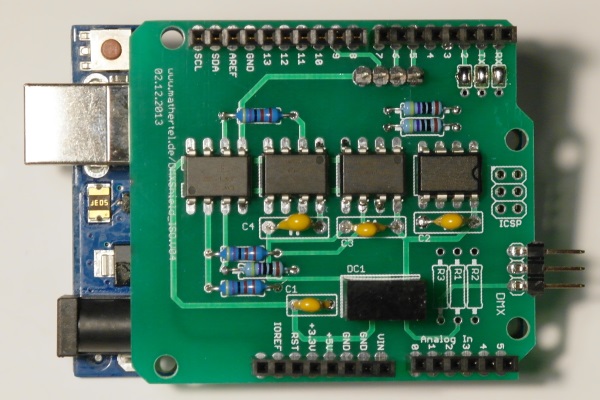
(click to open a full size picture).
When searching the internet you can see several chips being used to drive a DMX communication. They all are made to convert logic-level signals (LOW & HIGH) to the EIA-485 differential signal levels on the twisted pair cable.
Very common are the chips from MAXIM that I also use for my implementation. The one I prefer is the MAX485 or MAX481 which are identical with the exception of a low power shut down mode in MAX481 that we don’t need in the DMX scenario. MAX481 and MAX485 from MAXIM: http://www.maxim-ic.com/datasheet/index.mvp/id/1111
Other chips often used are the 75176b differential bus transceivers from Texas Instruments.
A typical schema using MAX481 for a DMX controller is:
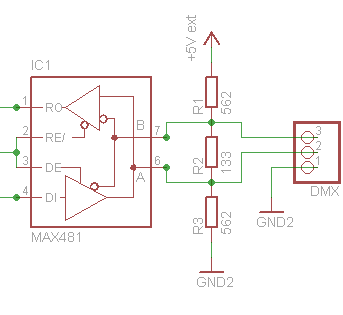
In addition a +5V supply must be connected to pin 8 and the ground level to pin 5 of the MAX481 chip.
The three resistors are the termination of the DMX bus. These resistors MUST be present at the controlling node of a DMX bus. R2 is eliminating echo packets while R1 and R3 keep the DMX line in logical HIGH state when no controller is sending. This is especially useful when implementing RDM supporting controllers.
A controller that is not designed for RDM can leave the resistors R1 and R3 and set the R2 Resistir to 120 Ω.
When using the DMX controller chip within a slave node the resistors on the board SHOULD NOT be populated at all. The last node of the DMX bus MUST be terminated using a termination socket with a 120 Ω inside.
The pin 2 of that chip controls whether the receive (pin 1) is active and pin 3 does the same for the output direction (pin 4). Because the pin 2 is internally inverted (marked as an invertion sign at pins 2 connection to the amplifier) both pins can connected together and can be controlled only by one logical signal. If the signal is high the output direction is enabled, if the signal is low, the input direction is enabled.
For a simple setup it is possible to connect the Driver chip directly to the Arduino pins but if you need a robust system, especially on a stage environment, you will have to add some more electronics to avoid electrical damage by defect equipment or accidental circumstances.
The electric potential of the DMX side of the implementation have to be isolated from the processor. There are 2 sort of chips that implement all you need:
There are 3 data signals from the arduino that have to be brought from the arduinos side to the DMX side: transmit, receive and the data direction:
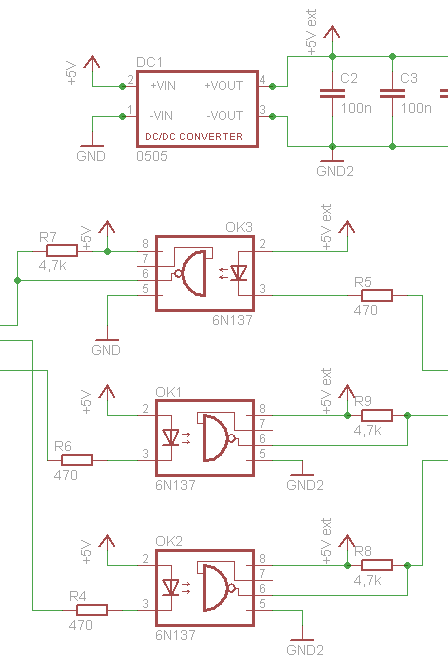
| Part name | Value | Description |
|---|---|---|
| Starting with the low parts... | ||
|
R4, R5, R6 |
470 Ω |
Bands: (yellow, purple, black, black, brown*) or (yellow, purple, brown, silver*) |
|
R7, R8, R9 |
4,7 kΩ |
Bands: (yellow, purple, black, brown, brown*) or (yellow, purple, red, silver*) |
| The resistors R1 - R3 should be adjusted for the
role of the DMX board in your DMX setup.
This configuration is for a DMX / RDM Controller. Don't use them when implementing a DMX or RDM Slave. |
||
|
R1, R3 |
562 Ω |
Bands: (green, blue, red, black, brown*) |
|
R2 |
133 Ω |
Bands: (brown, orange, orange, black, brown*) |
|
Now the capacitators... |
||
|
C1,C2,C3,C4 |
100n |
Capacitors stabilizing the power. Label: 104 |
| The dc-dc converter... | ||
|
DC1 |
NME 0505 |
A dc-dc-converter. The chip that provides another 5 v source for the DMX signal converter. |
|
Now you can check if the secondary 5v power is existing. Put it on top of an Arduino and measure the voltage at the capacitor C4. It should be near by 5V. |
||
|
The optocouplers and the driver chips... |
||
|
IC1 |
MAX481CPA |
A MAX481CPA or MAX485 CPA from Maxim or another supplier used to
convert the differential DMX signal into a logical signal. The 8 pin chip can be soldered directly or put on a socket. Be sure to place it in the right direction. |
|
OK1, OK2, OK3 |
6N137 |
The optocouplers. |
|
...and the connectors |
||
|
DMX |
1X03 pinhead. I cut it from a longer (20 pin) one. |
|
|
RGB |
1X04 pinhead |
|
|
stackable headers |
You can solder the usual stackable headers or if you use the shield at the uppermost shield on the Arduino you can solder simple pinheads too. |
|
|
ICSP |
There is no need caused by this shield to solder a ICSP. You can solder one if you like to use the shield with another shield above that needs these connections. |
|
|
solder jumpers |
Don’t forget to close the jumpers when using a standard Arduino. |
|
And here is a picture that shows where the parts are located on the board:
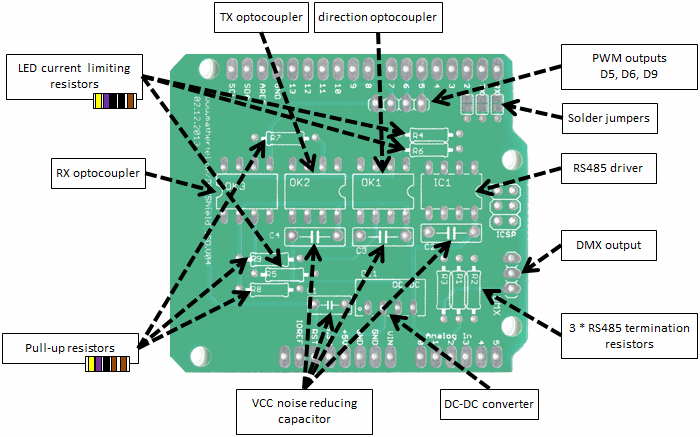
When equipping the board it is possible to let off some components and thus to achieve simplification and cost reduction.
Here is a picture of a partly assembled shield where all isolating components have been left off and only the sending and direction signal have been bridged:
You can see that only RX solder jumper is closed, the DC-DC converter and the pins 5 and 6 at OK1 are bridged.
Here is a picture of a partly assembled shield where all isolating components have been left off but all functions are enabled (send receive and direction switch:
All solder jumper are closed, the DC-DC converter is bridged and the wires skip the optocouplers.
Here is a picture of a partly assembled shield where only the rx is trasferred by using OK3.
I have included some comments in the parts list for using the board as a DMX Master, RDM Master and DMX/RDM Slave.
If you only need a DMX Master or DMX slave configuration the data direction can be set to a constant level.
If you only need to send then you should not connect the RX signal so you can still use the USB to upload sketches.
The most obvious features of the new (V04) version of the DMX Shield are the better placements of some of the components and the addition of all the shield connectors from the current Arduino boards.
The values from the optocoupler OK3 transferring the receiving signal in version v03 are adapted to the other optocouplers.
The 3 resistors (R4, R5, R6) are used to limit the current for the internal LEDs of the optocouplers. They had 300 or 470 Ohm in the first layout. These values are now made equal to 470 Ohm which is sufficient.
The 3 resistors (R7, R8, R9) are used to pull the output value of the optocoupler to HIGH also had different values of 470 or 4,7k Ohm. These values are now also made equal to 4,7k Ohm which is also sufficient. The downside of it is that the resistors are hard to distinguish.
I use both adjustments in some installations and they run fine.
The signals RX, TX and D2 are now brought to the pins d0, d1, d2 via a solder jumper. These 3 jumpers should be closed by dropping a small part of solder upon them for normal operation with Arduino Uno or Leonardo Boards.
If you like to use other serial ports or signals like on the Arduino MEGA you can leave these jumpers open and connect the signals the way you like.
The ICSP header of the Arduino board can now be brought to the next shield above the DMX shield by soldering a stackable header.
All the 4 holes from the Arduino Uno Board are now also available to the shield for building permanent robust stacks.
All of these extensions are not needed by the DMX shield but it is a good practice to have connection pads and holes at these positions so the signals can be passed through.
Some Arduino shields are using the ICSP header to access the SPI signals from the ATmega chip. The Ethernet shield is a good example for that and there are good reasons to do so.
Not the new version of the DMX shield has 6 contacts right where a ICSP connector can be soldered to pass through the signals to a shield above.
Also 2 of the Arduino header pins have been expanded since some versions. The POWER connector is now 8 pins long and includes IOREF signal. The upper digital connector is now 10 pins long and include the SDA and SCL signals.
Because the DMX shield does not need these signals you can leave these pins without soldering a header or use the (old) shorter headers if you like.
A schema design I used for designing this shield can be found at: http://www.mikrocontroller.net/topic/190608
This work is licensed under a BSD style license. See http://www.mathertel.de/License.aspx
This page is part of the http://www.mathertel.de/ web site.